Steps involved in our demo.
- Creating a Kubernetes deployment with Nginx image.
- Create a NodePort service to expose the Nginx application.
- Verify the Nginx connectivity after the service creation.
- Verify the details of the service and the nginx deployment.
- Delete the service and try accessing Nginx.
- Destroy the deployment.
Inspect the cluster.
Check for existing service, pod,replicaset, deployments etc.
rajith@k8s-master:~$ kubectl get svc
NAME TYPE CLUSTER-IP EXTERNAL-IP PORT(S) AGE
kubernetes ClusterIP 10.96.0.1 <none> 443/TCP 24d
rajith@k8s-master:~$ kubectl get deployments,rs,pods
No resources found in default namespace.
rajith@k8s-master:~$
In the current setup, we have only one service that is the default service coming along with the Kubernetes implementation.
Walk through the definition files.
We will have a look at our service and deployment definition files.
rajith@k8s-master:~$ cat nginx-deployment.yaml
apiVersion: apps/v1
kind: Deployment
metadata:
labels:
app: nginx-deployment
name: nginx-deployment
spec:
replicas: 3
selector:
matchLabels:
app: nginx-deployment
template:
metadata:
labels:
app: nginx-deployment
spec:
containers:
- image: nginx:1.16.1 #<--Image verion #
name: nginx
ports:
- containerPort: 80
rajith@k8s-master:~$
We are already familiar with the deployment definition file. We used the same during our demo for deployment.. If you need any clarification please have a look at it.
One additional point to be noted is the ‘labels’. The label which we defined here should match with the ‘selector’ in the service definition file. Another important point is the ‘containerPort’ defined in the deployment should match with the ‘targetPort’ in the service definition file.
Coming to the service defenition file.
rajith@k8s-master:~$ cat nginx-service.yaml
apiVersion: v1
kind: Service
metadata:
name: nginx-service
spec:
# By default the `service type ` is set to ClusterIp if it is not defined in the defenition file.
type: NodePort
selector:
app: nginx-deployment
ports:
# By default the `targetPort` is set to the same value as the `port` field.
- port: 80
targetPort: 80
# Optional field
# By default Kubernetes control plane will allocate a port from a range (default: 30000-32767)
nodePort: 30007
rajith@k8s-master:~$
We used the same service definition file in the previous module. If you need any details please have a look at it.
- Here the only difference is the name changed to ‘nginx-service’.
- The selector changed to ‘nginx-deployment’.
Make sure,
- The ‘selector’ in the service definition file matches with ‘labels’ in the deployment.
- The ‘targetPort’ in the service definition file matches with the ‘containerPort’ defined in the deployment.
Create the deployment
That’s it for now, we will create the deployment first.
rajith@k8s-master:~$ kubectl create -f nginx-deployment.yaml
deployment.apps/nginx-deployment created
rajith@k8s-master:~$ kubectl get pods
NAME READY STATUS RESTARTS AGE
nginx-deployment-5dfc477cf8-jqn6q 1/1 Running 0 7s
nginx-deployment-5dfc477cf8-vk8w4 1/1 Running 0 7s
nginx-deployment-5dfc477cf8-zvflg 1/1 Running 0 7s
rajith@k8s-master:~$ kubectl get pods -o wide
NAME READY STATUS RESTARTS AGE IP NODE NOMINATED NODE READINESS GATES
nginx-deployment-5dfc477cf8-jqn6q 1/1 Running 0 26s 10.32.0.3 node-3 <none> <none>
nginx-deployment-5dfc477cf8-vk8w4 1/1 Running 0 26s 10.32.0.2 node-3 <none> <none>
nginx-deployment-5dfc477cf8-zvflg 1/1 Running 0 26s 10.38.0.1 node-2 <none> <none>
rajith@k8s-master:~$
Deployment created, pods are running. We will come back to the ‘-o wide’ output after the service creation.
rajith@k8s-master:~$ kubectl create -f nginx-service.yaml
service/nginx-service created
rajith@k8s-master:~$ kubectl get svc nginx-service
NAME TYPE CLUSTER-IP EXTERNAL-IP PORT(S) AGE
nginx-service NodePort 10.99.197.69 <none> 80:30007/TCP 17s
rajith@k8s-master:~$
Inspect the service
The ‘nginx-service’ created. We need some detailed view of the service before going further.
"kubectl describe svc <name of the service >" is the command to view the details of the service.
rajith@k8s-master:~$ kubectl describe svc nginx-service
Name: nginx-service
Namespace: default
Labels: <none>
Annotations: <none>
Selector: app=nginx-deployment
Type: NodePort
IP Family Policy: SingleStack
IP Families: IPv4
IP: 10.99.197.69
IPs: 10.99.197.69
Port: <unset> 80/TCP
TargetPort: 80/TCP
NodePort: <unset> 30007/TCP
Endpoints: 10.32.0.2:80,10.32.0.3:80,10.38.0.1:80
Session Affinity: None
External Traffic Policy: Cluster
Events: <none>
rajith@k8s-master:~$
Here look at the endpoint IP and the port. We will take the output of pods with the ‘wide’ option once again.
rajith@k8s-master:~$ kubectl get pods -o wide
NAME READY STATUS RESTARTS AGE IP NODE NOMINATED NODE READINESS GATES
nginx-deployment-5dfc477cf8-jqn6q 1/1 Running 0 9m48s 10.32.0.3 node-3 <none> <none>
nginx-deployment-5dfc477cf8-vk8w4 1/1 Running 0 9m48s 10.32.0.2 node-3 <none> <none>
nginx-deployment-5dfc477cf8-zvflg 1/1 Running 0 9m48s 10.38.0.1 node-2 <none> <none>
rajith@k8s-master:~$
You can see the pod IP, 6th field matches with the endpoints.
To make it clear useing some filtering in the output.
rajith@k8s-master:~$ kubectl get pods -o wide |awk '{ print $6 }'
IP
10.32.0.3
10.32.0.2
10.38.0.1
rajith@k8s-master:~$ kubectl describe svc nginx-service |grep Endpoints
Endpoints: 10.32.0.2:80,10.32.0.3:80,10.38.0.1:80
rajith@k8s-master:~$
For those who are not familiar with the Unix command, the above are some basic filtering in Unix. Nothing to do with Kubernetes.
You can see the endpoints are automatically grabbed the pod IPs. This is because of the “Labels” and “Selector”.
Now our setup is ready. The Nginx application exposed outside the cluster. How do we test it? For that, you need to understand my lab setup.
Undersrand the lab setup
I am running this setup on my laptop in a virtual box installed on it. You can see the IP mapping from the below commands.
Host file from my laptop.
rajith@Shiva:~$ grep 192 /etc/hosts
192.168.50.10 k8s-master master
192.168.50.11 node-1 node01
192.168.50.12 node-2 node02
192.168.50.13 node-3 node03
rajith@Shiva:~$
See the node IPs.
rajith@k8s-master:~$ kubectl get node -o wide
NAME STATUS ROLES AGE VERSION INTERNAL-IP EXTERNAL-IP OS-IMAGE KERNEL-VERSION CONTAINER-RUNTIME
k8s-master Ready control-plane,master 24d v1.21.1 192.168.50.10 <none> Ubuntu 20.04.2 LTS 5.4.0-73-generic docker://20.10.6
node-1 Ready <none> 24d v1.21.1 192.168.50.11 <none> Ubuntu 20.04.2 LTS 5.4.0-73-generic docker://20.10.6
node-2 Ready <none> 24d v1.21.1 192.168.50.12 <none> Ubuntu 20.04.2 LTS 5.4.0-73-generic docker://20.10.6
node-3 Ready <none> 24d v1.21.1 192.168.50.13 <none> Ubuntu 20.04.2 LTS 5.4.0-73-generic docker://20.10.6
rajith@k8s-master:~$
See the 6th field from the above output. Here is the IP mapping.
- 192.168.50.10 -> master
- 192.168.50.11 -> node-1
- 192.168.50.12 -> node-2
- 192.168.50.13 -> node-3
rajith@k8s-master:~$ kubectl get pod -o wide
NAME READY STATUS RESTARTS AGE IP NODE NOMINATED NODE READINESS GATES
nginx-deployment-5dfc477cf8-jqn6q 1/1 Running 0 28m 10.32.0.3 node-3 <none> <none>
nginx-deployment-5dfc477cf8-vk8w4 1/1 Running 0 28m 10.32.0.2 node-3 <none> <none>
nginx-deployment-5dfc477cf8-zvflg 1/1 Running 0 28m 10.38.0.1 node-2 <none> <none>
rajith@k8s-master:~$
Pods are running on node-2 and node-3. The corresponding IP is ‘192.168.50.12’ and ‘192.168.50.13’. We will see this IP from my laptop browser.
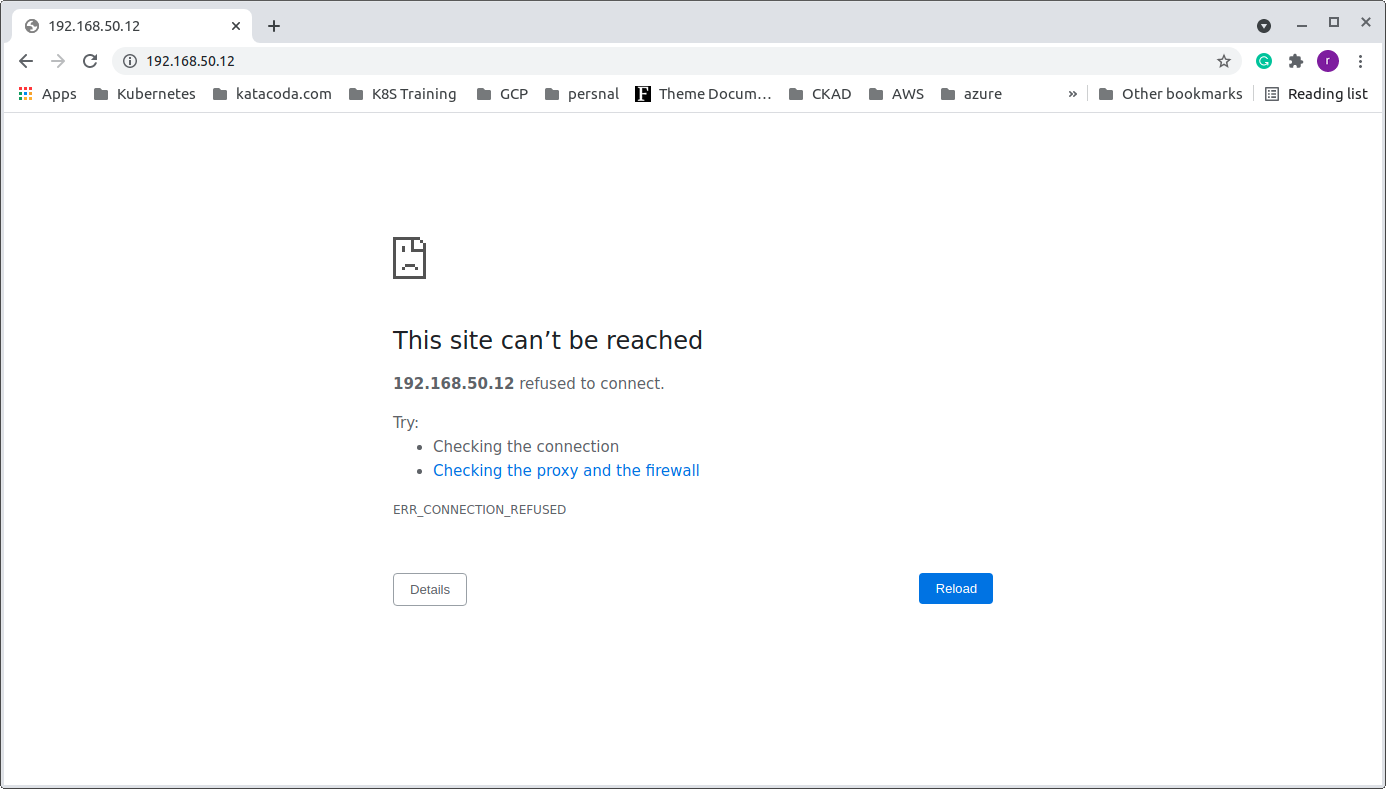
What happened? the Nginx welcome page is not showing! 😳
rajith@k8s-master:~$ kubectl describe svc nginx-service |grep NodePort
Type: NodePort
NodePort: <unset> 30007/TCP
rajith@k8s-master:~$
We need to use the NodePort along with the IP to access the page. Try accessing 192.168.50.12:30007.
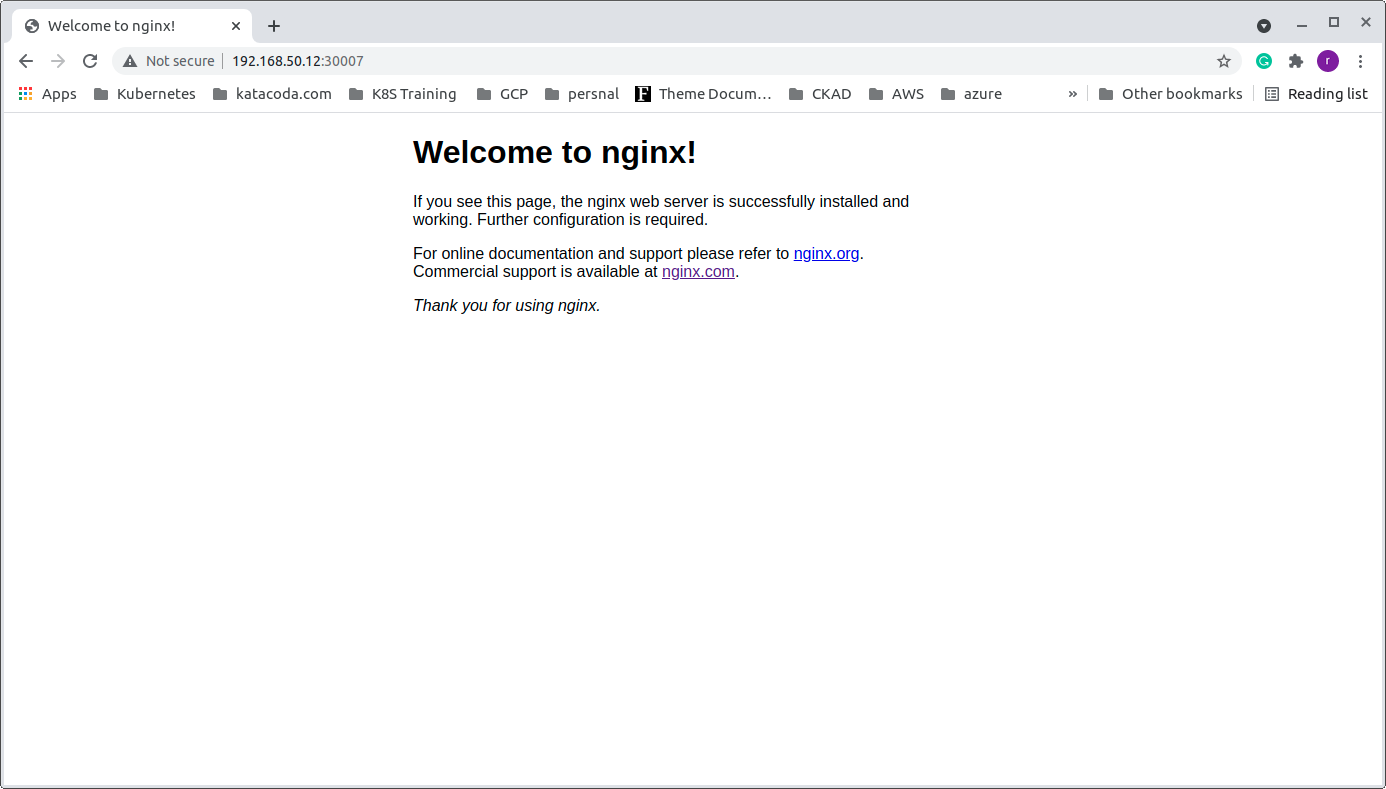
Yes, it is working.😊
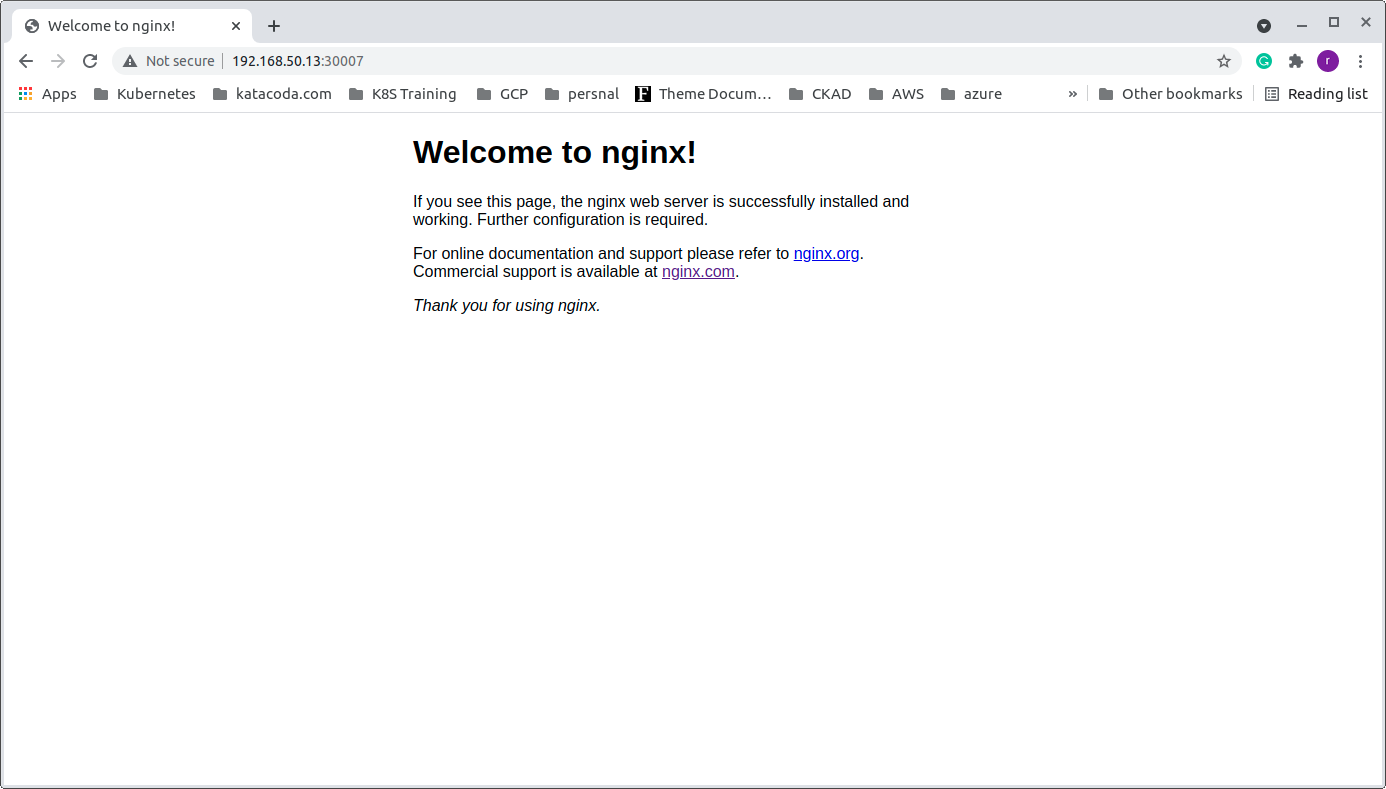
Yes, that also works. Perfect all good 👍.
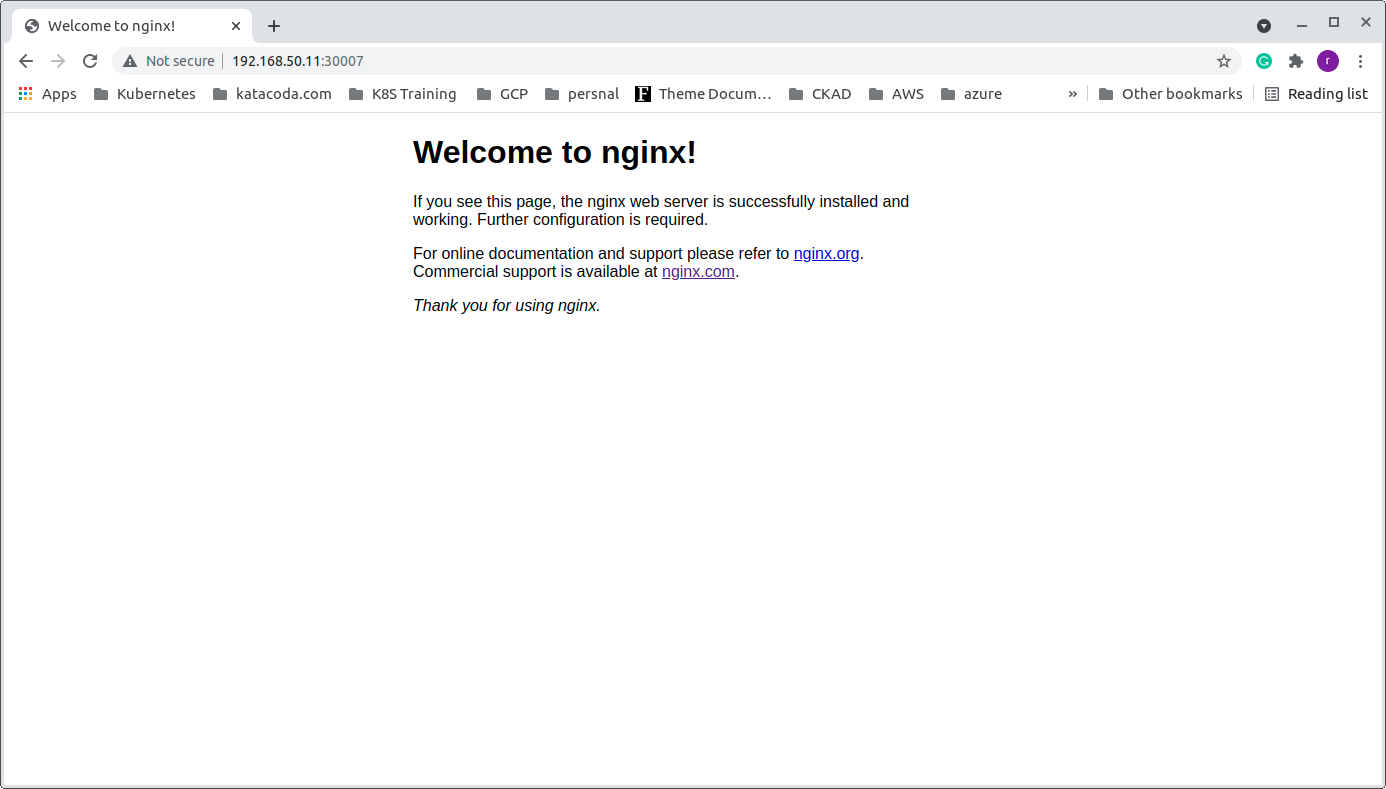
We will try accessing with the node-01 IP. “192.168.50.11:30007”.
That also gives the welcome page!!🤔
Let me try the master node “192.168.50.10:30007.
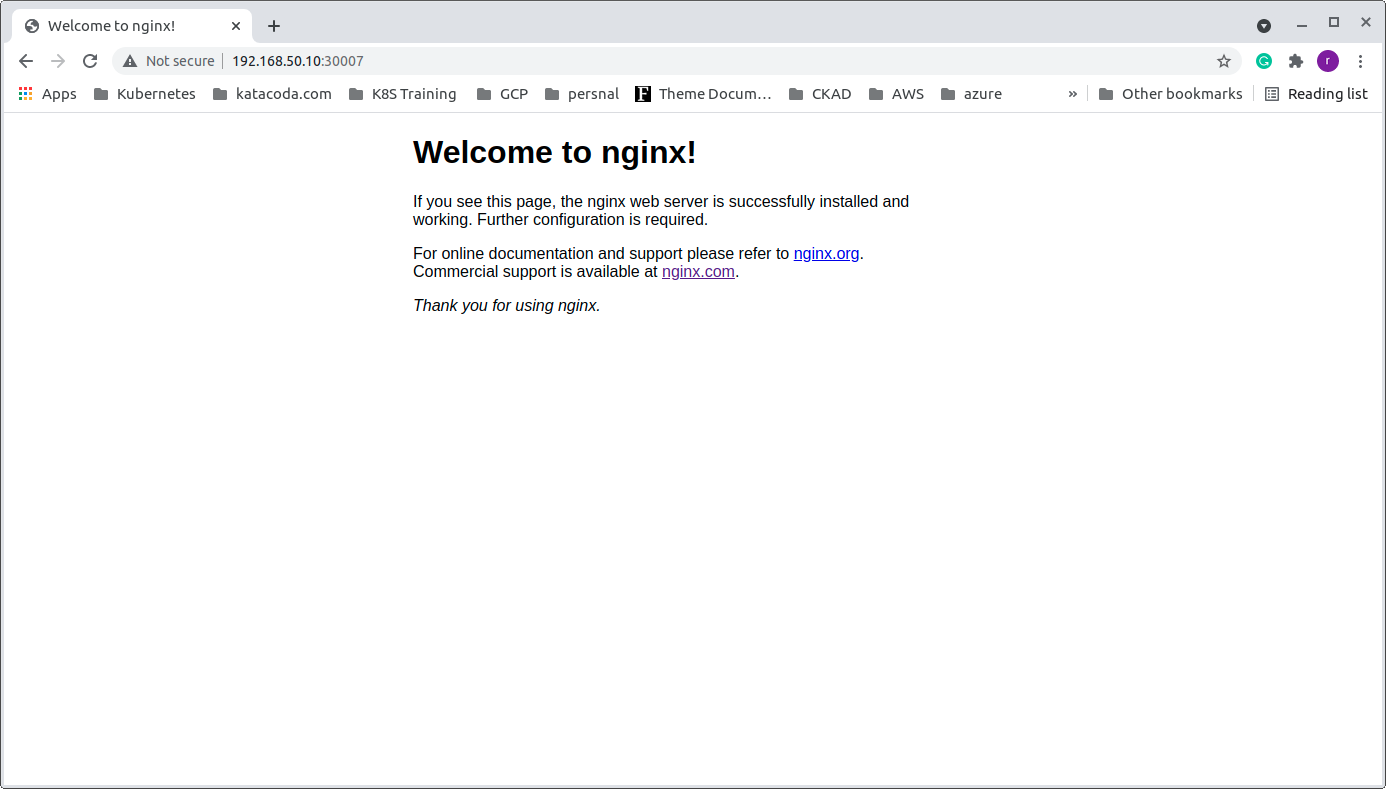
That is also showing the same!! 😇
What’s happening? The pods are started only on node-2 and node-3. But all the nodes includes the master node IP showing the ‘Nginx welcome page’ ??
Are we doing something wrong? 😫
No, that’s how the NodePort service designed to work. It serves through all the nodes IP. There is an internal forwarding. We will discuss this in another series.
Hope, you are with me. We will delete the service and see what happens.
rajith@k8s-master:~$ kubectl delete service nginx-service
service "nginx-service" deleted
rajith@k8s-master:~$ kubectl get service
NAME TYPE CLUSTER-IP EXTERNAL-IP PORT(S) AGE
kubernetes ClusterIP 10.96.0.1 <none> 443/TCP 24d
rajith@k8s-master:~$ kubectl get pods -o wide
NAME READY STATUS RESTARTS AGE IP NODE NOMINATED NODE READINESS GATES
nginx-deployment-5dfc477cf8-jqn6q 1/1 Running 0 53m 10.32.0.3 node-3 <none> <none>
nginx-deployment-5dfc477cf8-vk8w4 1/1 Running 0 53m 10.32.0.2 node-3 <none> <none>
nginx-deployment-5dfc477cf8-zvflg 1/1 Running 0 53m 10.38.0.1 node-2 <none> <none>
rajith@k8s-master:~$
Service is deleted but pods are running. We will see the application available through the browser.
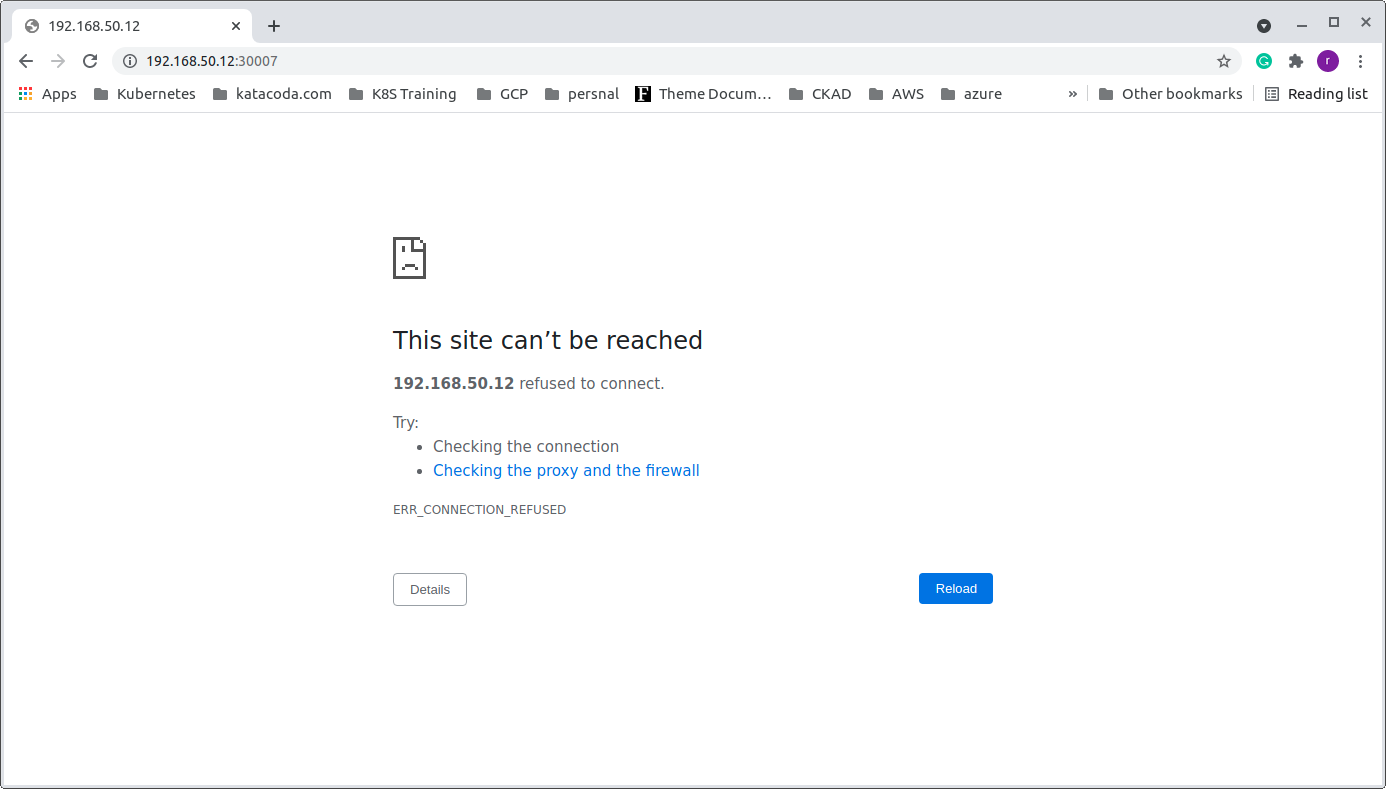
No, the “Nginx welcome page” is not available now. Even if the pods are running, we need the service to access the application externally.
We will do the cleanup.
rajith@k8s-master:~$ kubectl get deployments,rs,pods,svc
NAME READY UP-TO-DATE AVAILABLE AGE
deployment.apps/nginx-deployment 3/3 3 3 3h45m
NAME DESIRED CURRENT READY AGE
replicaset.apps/nginx-deployment-5dfc477cf8 3 3 3 3h45m
NAME READY STATUS RESTARTS AGE
pod/nginx-deployment-5dfc477cf8-jqn6q 1/1 Running 0 3h45m
pod/nginx-deployment-5dfc477cf8-vk8w4 1/1 Running 0 3h45m
pod/nginx-deployment-5dfc477cf8-zvflg 1/1 Running 0 3h45m
NAME TYPE CLUSTER-IP EXTERNAL-IP PORT(S) AGE
service/kubernetes ClusterIP 10.96.0.1 <none> 443/TCP 25d
rajith@k8s-master:~$ kubectl delete -f nginx-deployment.yaml
deployment.apps "nginx-deployment" deleted
rajith@k8s-master:~$
Now we got a clear idea of how the Kubernetes service works and how it’s related to the other components in the cluster.
Next, we will have a discussion on Kubernetes volume and persistent volume.
